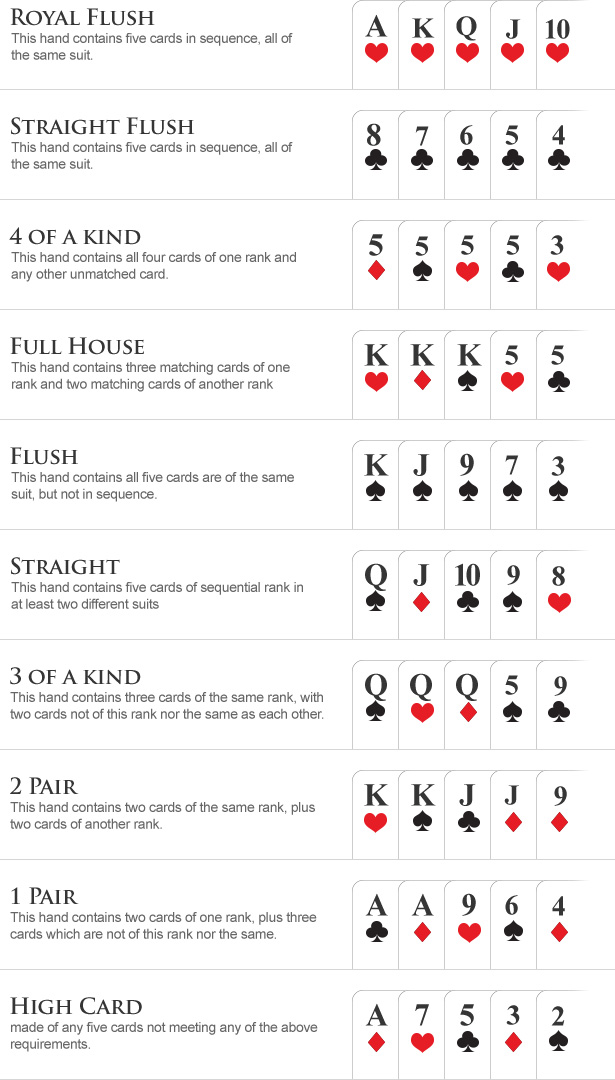Texas Holdem Poker Hands Rules
- Poker Hands Rules Texas Hold Em
- Texas Holdem Poker Rules And Hands
- Texas Holdem Poker Hands Rules Card Game
- Texas Holdem Poker Hands Rules Against

- Texas Hold’em Rules – an Idiot’s guide By Thomas Nielsen — on April 7th, @ 13:11 PST Every player is dealt two cards, known as ‘hole cards’ and each player then decides whether to bet or fold their hand, depending on whether they think they will win the hand. The dealer then draws three cards and puts them face-up on the table.
- When playing Texas Holdem poker, every player is dealt two cards face down – these are called your 'hole cards'. Then there is a round of betting where you can Check, Bet or Fold. This stage of the game is known as pre-flop and what you should do is dependent on those hole cards, or starting hand.
- Texas Holdem Poker Hand Rankings In Order. The first things that you need to learn when playing Texas Holdem are rules and poker hand rankings. Without knowing what beats what you will be struggling to move forward. Thus, spending a few minutes going over the list of poker hands in order will pay for itself in no time.
The two players to the left of the dealer must post these compulsory “blinds” – so called because they are placed before anyone even sees their cards. The player on the dealer’s immediate left posts the “small blind” and the player one further seat round the table posts the “big blind”, which is usually twice the size of the small.
The first three cards in Texas Hold'em are called the Flop. These cards are “community cards” meaning everyone will use them in combination with their own hole cards to make the best hand. From the flop on, betting begins with the player to the dealer’s left, who can check or bet. A fourth card is dealt face up onto the board. Texas hold 'em (also known as hold'em or holdem) is another version of the standard card game of poker. A dealer shuffles the cards then deals 2 cards to each player and then five community cards are placed by the dealer—a series of three ('the flop') then two additional single cards ('the turn' and 'the river').
In the illustration, the dealer is in seat five with the button in front of him. The two seats to his left are “in the blinds”.
Poker Hands Rules Texas Hold Em
After every hand is complete, the dealer button moves clockwise one position around the table, which means that players take turns to be the dealer, the small blind and the big blind.
Texas Holdem Poker Rules And Hands
After the blinds have been posted, all players are dealt two cards face down. These are known as “hole” cards, and can only be seen and used by one player. By the end of the hand, five more “community” cards may have been dealt, face up in the middle of the table, which are available for all players to use.
The first three of the community cards are exposed together (known as the “flop”), then a fourth card (known as the “turn”) is dealt individually, and then a fifth (known as the “river”) is exposed. A betting round separates each deal.
The aim of poker is to make the best five-card hand out of the seven available – two in an individual’s hand and the five community cards.
The Four Betting Rounds
If a hand of poker is played all the way to its conclusion, there will be four betting rounds – or four periods during which players can commit their chips to the pot. A player can also “fold” their cards and leave the action at any time (see below).
A betting round must be concluded satisfactorily before the remaining players see more cards and another betting round begins.
Pre-Flop – The First Round of Betting
The first betting round takes place before the first three community cards (the “flop”) are dealt. This action is described as “pre-flop” and at this stage players are wagering based solely on the strength of their two concealed “hole” cards.
Texas Holdem Poker Hands Rules Card Game
The player sitting to the left of the big blind acts first – a position known as “under the gun”. Players then act in turn, moving clockwise around the table.
Texas Holdem Poker Hands Rules Against
You have the following options when it is your turn to act:
- Fold: This means that you no longer want to play the hand, and are throwing your cards away. You no longer have any claim to the money in the pot, even if you paid one of the blinds.
- Call: This means that you want to play the hand by matching the size of the current bet. Pre-flop, this will be at least the size of the big blind, and may be greater if any other player has raised.
- Raise: This means that you want to raise the size of the current bet. If nobody before you has made a raise, you can make a raise yourself.
- If you are sitting in the big blind and no else has raised before you, you have the option to check. This means that you do not wish to commit any more chips to the pot. You can only check pre-flop if you are in the big blind and no one else raised.

/best-starting-hands-texas-hold-em-412253_final-6f77b6e535ed49dd81ecb6edfb536b81.png)
Texas hold 'em (also known as hold'em or holdem) is another version of the standard card game of poker. A dealer shuffles the cards then deals 2 cards to each player and then five community cards are placed by the dealer—a series of three ('the flop') then two additional single cards ('the turn' and 'the river'). Players have the option to check, bet or fold after each deal, i.e. betting may occur prior to the flop, 'on the flop,' 'on the turn,' and 'on the river.'

Texas hold 'em players compete either for an amount of money or chips contributed by the players themselves (this is called the pot). Because the cards are dealt randomly and outside the control of the players, each player attempts to control the amount of money in the pot based on the hand he or she is holding.
The game is made up of a series of hands or deals. At the conclusion of each hand, the pot is usually awarded to one player (although it can on occasions be split). A hand may end at the showdown, in which case the players that are still in play, compare their hands and the highest hand is naturally awarded the pot. Another possible outcome of a hand is when all but one player have folded and given up any claim to the pot, in which case the pot is awarded to the player who has not folded and is therefore still in play
When a Texas Hold'em Poker player wants to play poker, the general objective is not to win every individual hand, but rather to make mathematically and psychologically correct decisions regarding at what point and how much to bet, raise, call or fold. By skilfully making such decisions, successful Texas Hold'em Poker players maximize winnings in the long term.